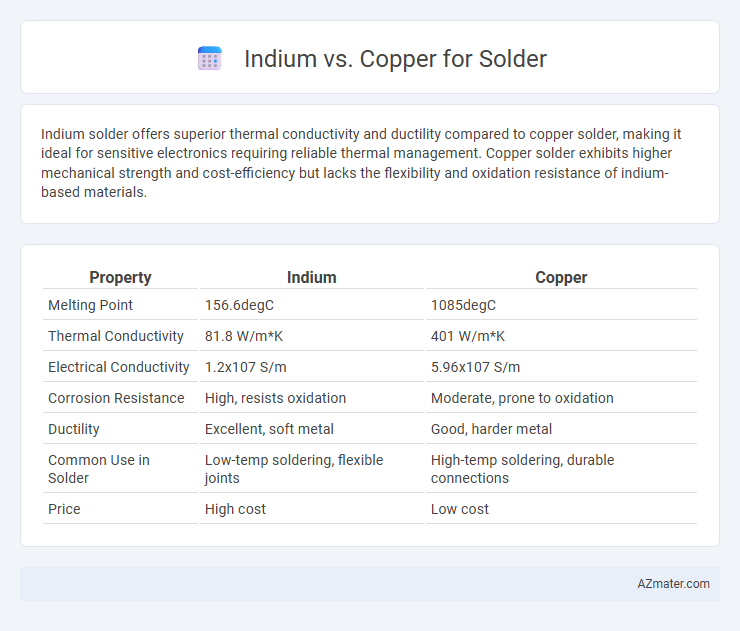Indium solder offers superior thermal conductivity and ductility compared to copper solder, making it ideal for sensitive electronics requiring reliable thermal management. Copper solder exhibits higher mechanical strength and cost-efficiency but lacks the flexibility and oxidation resistance of indium-based materials.
Table of Comparison
| Property | Indium | Copper |
|---|---|---|
| Melting Point | 156.6degC | 1085degC |
| Thermal Conductivity | 81.8 W/m*K | 401 W/m*K |
| Electrical Conductivity | 1.2x107 S/m | 5.96x107 S/m |
| Corrosion Resistance | High, resists oxidation | Moderate, prone to oxidation |
| Ductility | Excellent, soft metal | Good, harder metal |
| Common Use in Solder | Low-temp soldering, flexible joints | High-temp soldering, durable connections |
| Price | High cost | Low cost |
Introduction to Indium and Copper in Soldering
Indium and copper are essential metals used in soldering, each offering distinct advantages based on their physical and chemical properties. Indium provides superior wetting ability, low melting point around 157degC, and excellent thermal and electrical conductivity, making it ideal for sensitive electronic applications requiring flexible, reliable joints. Copper, with a higher melting point of 1085degC and superior mechanical strength, is commonly used in traditional solder alloys to reinforce joints and enhance durability in high-temperature environments.
Chemical Properties: Indium vs Copper
Indium exhibits a much lower melting point (156.6degC) compared to copper (1085degC), making it ideal for low-temperature solder applications, while copper's high melting point ensures superior thermal and electrical conductivity but requires higher soldering temperatures. Chemically, indium is more resistant to oxidation and corrosion, maintaining solder joint integrity in harsh environments, whereas copper tends to oxidize rapidly, often necessitating flux or protective coatings. Indium's softness and ductility contrast with copper's hardness and rigidity, influencing mechanical reliability and thermal stress tolerance in electronic assemblies.
Thermal Conductivity Comparison
Indium exhibits a thermal conductivity of approximately 81.8 W/m*K, which is significantly lower compared to copper's thermal conductivity of about 400 W/m*K, making copper superior for heat dissipation in solder applications. Copper's high thermal conductivity allows for efficient heat transfer in electronic assemblies, whereas indium's comparatively lower value limits its effectiveness in thermal management despite its excellent wetting properties. The choice between indium and copper solder materials should consider copper's advantage in thermal performance for applications requiring rapid heat dissipation.
Electrical Conductivity Performance
Indium solder exhibits lower electrical conductivity compared to copper, with copper's conductivity approximately 59.6 MS/m, while indium registers around 1.2 MS/m. Copper's superior conductivity enhances signal integrity and reduces resistive losses in electronic connections. For applications prioritizing optimal electrical performance, copper remains the preferred solder material due to its high conductivity and reliable electron transport characteristics.
Melting Points and Solder Joints
Indium solder melts at approximately 157degC, significantly lower than copper's melting point of 1,085degC, allowing Indium to create solder joints with less thermal stress on sensitive components. Indium's excellent wettability and ductility result in flexible, reliable solder joints, particularly in low-temperature or cryogenic applications. Copper, while unsuitable as a solder due to its high melting point, serves as a common substrate or conductor in joints that utilize Indium or other low-melting-point solder alloys.
Oxidation Resistance and Longevity
Indium solder exhibits superior oxidation resistance compared to copper-based solder, minimizing surface degradation and preserving electrical conductivity over time. This enhanced oxidation resistance contributes to greater longevity in electronic assemblies where exposure to environmental factors can accelerate copper solder oxidation. Consequently, Indium-based solder maintains mechanical integrity and reliable connections longer than traditional copper solder under harsh operating conditions.
Compatibility with Various Substrates
Indium solder offers superior compatibility with a wide range of substrates including ceramics, glass, and metals due to its low melting point and ductile nature, reducing thermal stress during bonding. Copper, commonly used in traditional solders, provides excellent electrical conductivity but may require fluxes or surface treatments to bond effectively with non-metallic substrates. Indium's ability to form reliable joints with sensitive and diverse materials makes it preferable in advanced electronics and aerospace applications.
Application-Specific Suitability
Indium solder excels in applications requiring superior thermal conductivity, flexibility, and corrosion resistance, making it ideal for aerospace, cryogenics, and sensitive electronic components. Copper solder, favored for its high electrical conductivity and mechanical strength, is widely applied in power electronics, plumbing, and automotive industries where durability and cost-effectiveness are critical. Selection between indium and copper solder depends on factors like operating temperature, mechanical stress, and environmental exposure to optimize joint reliability and performance.
Cost and Availability Analysis
Indium solder is significantly more expensive and less readily available than copper solder, largely due to indium's rarity and demand in specialized applications like electronics and aerospace. Copper solder offers a cost-effective alternative with widespread availability, making it suitable for mass production and general electronics manufacturing. The high price and limited supply of indium constrain its use to high-performance or niche projects where unique properties justify the expense.
Choosing the Right Metal: Indium or Copper?
Indium offers superior thermal conductivity and excellent wetting properties for high-performance solder joints, especially in electronics requiring precision and reliability. Copper provides better mechanical strength and corrosion resistance, making it ideal for robust electrical connections and industrial applications. Selecting between indium and copper depends on the balance between thermal efficiency, mechanical durability, and specific application requirements in soldering processes.

Infographic: Indium vs Copper for Solder
 azmater.com
azmater.com